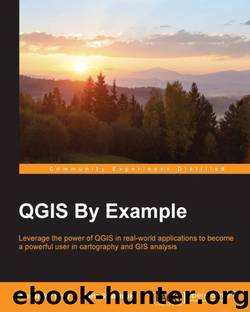QGIS By Example by Bruy Alexander & Svidzinska Daria

Author:Bruy, Alexander & Svidzinska, Daria
Language: eng
Format: epub
Publisher: Packt Publishing
Published: 2015-06-28T16:00:00+00:00
In the previous steps, you defined some major options. As we need to create a raster with exactly the same extent and resolution as lidar_dem.tif, we will use advanced options by editing the gdal_rasterize command-line parameters: Click on the Edit button to make the line editable. All the previous options will be deactivated and grayed out.
Delete the –ts 3000 3000 option, as we are going to specify a resolution parameter that makes raster width and height parameters that are defined by –ts meaningless.
The –init 0 parameter defines the initial values of the output raster. It creates an empty raster with initially predefined values, and then vector values are burned into it. In our case, this means that building-free areas will be assigned zero values.
The target extent is defined by the –te parameter described by space-separated bounding box values (Xmin, Ymin, Xmax, and Ymax) in georeferenced units. If you want to use a predefined extent, just copy its values from a piece of correspondent raster metadata. Don't forget to replace the commas and semicolons with spaces.
The target resolution (–tr) parameter defines the vertical and horizontal pixel size in units specified by the layer's CRS.
The output data type is defined by the –ot parameter, whose default value is Float64, but we replace it by Float32, which is the same as that for lidar_dem.tif.
Download
This site does not store any files on its server. We only index and link to content provided by other sites. Please contact the content providers to delete copyright contents if any and email us, we'll remove relevant links or contents immediately.
Grails in Action by Glen Smith Peter Ledbrook(9163)
Sass and Compass in Action by Wynn Netherland Nathan Weizenbaum Chris Eppstein Brandon Mathis(8808)
Azure Containers Explained by Wesley Haakman & Richard Hooper(7442)
Configuring Windows Server Hybrid Advanced Services Exam Ref AZ-801 by Chris Gill(7432)
Kotlin in Action by Dmitry Jemerov(7263)
Running Windows Containers on AWS by Marcio Morales(6982)
Microsoft 365 Identity and Services Exam Guide MS-100 by Aaron Guilmette(5400)
Microsoft Cybersecurity Architect Exam Ref SC-100 by Dwayne Natwick(5209)
Combating Crime on the Dark Web by Nearchos Nearchou(4979)
The Ruby Workshop by Akshat Paul Peter Philips Dániel Szabó and Cheyne Wallace(4667)
Management Strategies for the Cloud Revolution: How Cloud Computing Is Transforming Business and Why You Can't Afford to Be Left Behind by Charles Babcock(4527)
Python for Security and Networking - Third Edition by José Manuel Ortega(4233)
The Age of Surveillance Capitalism by Shoshana Zuboff(4209)
Learn Wireshark by Lisa Bock(4116)
The Ultimate Docker Container Book by Schenker Gabriel N.;(3886)
Learn Windows PowerShell in a Month of Lunches by Don Jones(3681)
DevSecOps in Practice with VMware Tanzu by Parth Pandit & Robert Hardt(3568)
Windows Ransomware Detection and Protection by Marius Sandbu(3540)
Blockchain Basics by Daniel Drescher(3507)
